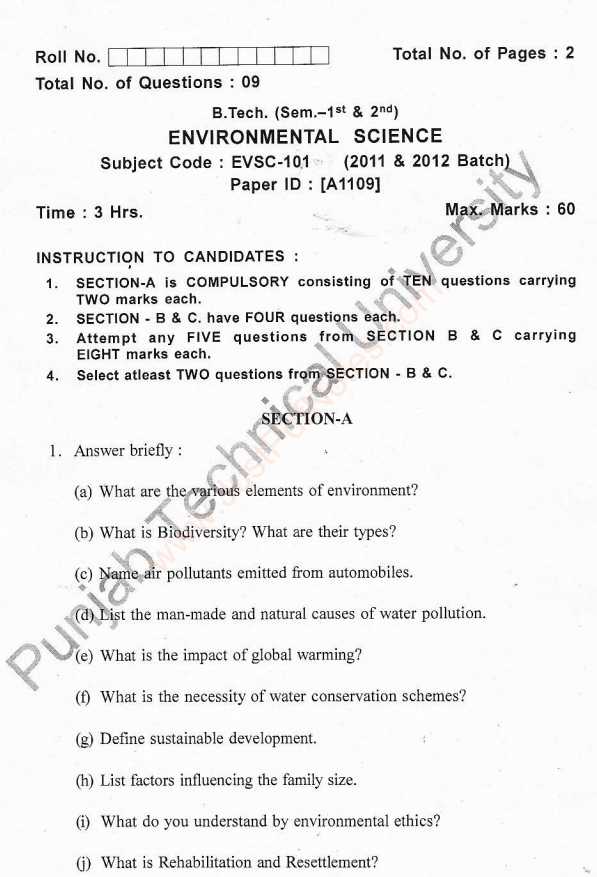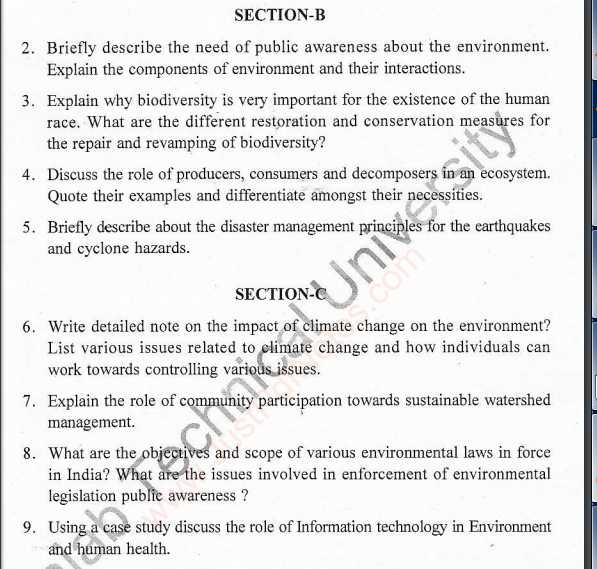|
#1
March 30th, 2017, 05:40 PM
| |||
| |||
| PTU Evs Notes
Hello sir, is there any one can provide me here notes for Environmental Studies from the Punjab Technical University? The Punjab Technical University is reveals the subjects for the first and second semesters but the Institutions use this subject according to them. But Institutions have to complete all the compulsory subjects given by University in a year. Question for Environmental Studies from the Punjab Technical University:   Questions for EVSA from PTU: ENVIRONMENTAL SCIENCE Q: 1 What do you mean by Zooplanktons? Ans: All the tiny aquatic animals eaten by fish are known as Zooplankton. Q: 2 What is yard waste? Ans: Leaves, grass, clippings and other organic wastes produced as part of yard and garden development and maintenance. Q: 3 What do you mean by wetland? Ans: Semi-aquatic land, land that is either incmlated or saturated by water for varying periods of time during each year, and that supports aquatic vegetation which is specifically adapted for saturated soil conditions. Q: 4 What are volatile organic compounds? (VOC) Ans: VOC: are made as secondary petrochemicals. They include light alcohols, acetone, trichloroethylene, benzene, vinyl chloride etc. Q: 5 What is vermicomposting? Ans: The use of red worms to compost organic waste is known as vermicomposting. Q: 6 Define Turbidity. Ans: The property of water which prevents the passage of light through it , usually caused by the presence of light through it , usually caused by the presence or suspended and colloidal impurities in water. Q: 7 What is Trammel? Ans: A rotary cylindrical season that is typically inclined at a downward angle that, combined with the tumbling action of trammel, separates materials of different density. Q: 8 Define thermal pollution? Ans: The impairment of water quality through temperature increase usually occurs as result of industrial cooling water discharge. Q: 9 Define Sedimentation. Ans: The gravity settling, and thus removal of materials more dense than the suspending fluid. Q: 10 What do you understand by photochemical smog? Ans: Air pollution caused by chemical reaction of various pollutants emitted from different sources. Q: 11 Define source reduction. Ans: The elimination or reduction of the waste of the source by modification of the actual process which produces the waste. Q: 12 What is Runoff? Ans: Water from precipitation or irrigation that flows over the ground surface and returns to streams. It can collect pollutants from the air or land and carry them to the receiving water. Q: 13 What is rubbish? Ans: Solid waste that does not contain food waste is known as Rubbish. Q: 14 What is Radon? Ans: Colorless, odorless radioactive gas formed by the decay of radium. When trapped in buildings concentrations build up, and it can cause health hazards such a lung cancer. Q: 15 Define risk assessment. Ans: The qualitative and quantitative evolution performed in an effort to define the risk posed to human health and/or the environment by the presence or potential presence/or use of specific pollutants. Q: 16 Define Prokaryotic organisms? Ans: Organisms which do not have a cellular membrane. Q: 17 'Pesticides' define it? Ans: A substance or mixture of substance intended for preventing, destroying, repelling, or mitigating any pest. Q: 18 Define Plume. Ans: In water terms, the extent or boundary of the spread of underground soil or water contamination. In air, a visible emission from a flue or chimney. Q: 19 What is ozone layer? Ans: The layer of the upper atom in which a concentration absorbs a significant amount of potentially, hazardous ultraviolet radiation. Q: 20 What is PET? Ans: It is polyethylene Terapthlene, a type of plastic that is clear or coloured transparent with high gloss. It is used for carbonated beverage bottles and some household cleanser container. Q: 21 What do you mean by organic compounds? Ans: Chemical compounds containing carbon. Historically organic compounds were obtained from vegetable or animal sources. Q: 22 Define Nitrification? Ans: The biological oxidation of ammonia and ammonium sequentially to nitrate and then nitrate. It occurs naturally in surface waters and can be engineered in waste water treatment. Q: 23 Define Nitrogen fixation. Ans: The conversion of atmospheric (or dissolved) nitrogen gas into nitrate by microorganisms. Q: 24 What is NGO? Ans: It is Non governmental organization central around a cause or causes that works outside the sphere of government. Q: 25 'Non point source' comment on it. Ans: Water contaminant that can't be traced to a specific point of origin but rather comes from many different non-specific sources. Q: 26 Define Mycorrhizae. Ans: A symbiotic soil fungi, present in most soils that attack themselves directly on to the roots of most plants. They help the host plants absorb more water and nutrients while the host plants provide food for the fungi. Q: 27 What do you mean by Land filling? Ans: The placement of wastes into the land under controlled conditions to minimize their migration or effect on the surrounding environment. Q: 28 Define leaching process. Ans: The act of dissolving the soluble position of a solid mixture by some solvent. An example is the dissolving of inorganic or organic contaminants from refuse in a landfill by infiltrating rain water. Q: 29 Define LLDPE. Ans: It is linear low density polyethylene. Q: 30 What do you understand by Incineration? Ans: The process of burning wastes under controlled conditions is known as Incineration. Q: 31 What is Hydrologic cycle? Ans: A cyclic movement of water from ocean to the atmosphere by evaporation through rain to earth's surface, through run off and ground water to streams, and back to the sea. Q; 32 What is inversion? Ans: An atmospheric conditions occurring when a layer of cool air is trapped by a layer of warm air and is unable to rise. It spread polluted air horizontally rather than vertically. Q: 33 What is Hydrofluorocarbons (HFCs)? Ans: Chemicals with fluorine but no chlorine, and therefore likely not damaging to the ozone layer. HFCs are potent green house gases. Q: 34 What is HUMUS? Ans: The substance which results from decay of plant or animals matter. Biodegradable matter from humus as they decompose. Q: 35 What are various hazardous waste? Ans: Waste materials that are inherently dangerous in contact, handling and disposal. Radioactive materials and some biological wastes are also considered hazardous. Q: 36 What is Esturay? Ans: Special environments at the mouth of coastal rivers where fresh water meets sea water. Q: 37 What is Eukaryotic organisms? Ans: Organisms which possess a nuclear membrane. This includes all known organisms except viruses and bacteria. Q: 38 What is food chain? Ans: A sequence of organisms, each of which uses the next, lower member of the sequence as a food source. Q: 39 What is food web? Ans: A complex intermeshing of individual food chain is an ecosystem. Q: 40 Define term Genome. Ans: All the genes of a particular organism or species is known as Genom. Last edited by Neelurk; April 2nd, 2020 at 04:07 PM. |